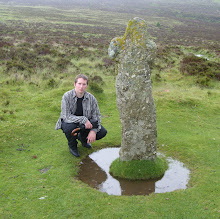





This weekend we went to visit the Isle of Portland, in Dorset. I wanted to visit the sea caves. When we arrived I noticed the coast was every bit as romantic as that of Cornwall. Portland is what Thomas Hardy called, "carved by Time out of a single stone". It is certainly fascinating from a geological, ecological and historical point of view. I was most interested in going to visit the sea caves. We walked along the South West Coast path, - a long distance route that is more than 1000 miles in all! - to reach the caves, where we found Cave Hole.
It would seem that Cave Hole has a natural blow hole in the cliff, which has been secured with a steel grate for safety but from which you could stand in stormy weather or when the tide is high and get splashed or feel the power of the waves.


In their book Dark Dorset, Robert Newland and Mark North tell the grisly tale of the Roy Dog of Portland, a phantom black dog which haunts Cave Hole. They even use an artist's impression of this for the cover of their book:

In this tale, three men are fishing at Cave Hole. Two decide to go home as the weather has taken a turn for the worst, but the third insists on staying until he has caught something. On their way back, the two men met the lighthouse keeper who told them he thought evil was afoot as the lighthouse would not function properly. Shortly after this, when they went to get a drink of water, the two men met the Roy Dog itself, as big as a man and "like something out of HP Lovecraft." Apparently it has two different fiery coloured eyes, one red one green, and the eyes of the victims plucked from their heads dangle from its black mane of fur. They ran as fast as they could to get home. Next morning they returned to Cave Hole to see if their friend was still there fishing, and found him lying dead with his eyes plucked out on Cave Hole. Attached to his fishing rod was a piece of flesh and a large claw, and they concluded that he had caught the Roy Dog.
Newland & North speculate that the Roy Dog legend could be a corruption of the ancient Germanic myths of the Rye Wolf or Corn Dog. Portland was certainly populated in ancient times for such a myth to grow. Although the Dog itself behaves more like a water spirit, luring people to their dooms.

We however survived Cave Hole partly by not going too near the edge, yet walked fairly strenous length of the South West Coast path for about 4 miles up and down the cliffs. At times the views were breathtakingly spectacular. Finally we arrived at a place called Church Ope Cove. This beach was secluded and very beautiful. The portland stone pebbles were smooth and grey and the exact colour and texture that sea pebbles are supposed to be.




I thought this was the sort of beach were one could expect to see mermaids. We turned to face the shore, and could see the ruins of Rufus Castle overlooking the beach, and next to it the romantic ruins of the mediaeval St Andrews Church. This church was ransacked by the French before being abandoned to the sea due to crumbling cliffs.
According to the official Portland website, there are real pirates' graves in this churchyard. But we could not decide which ones they were.


The Dark Dorset book states that according to folklore, a mermaid once came ashore on this beach. Whether the mermaid was washed ashore after expiring, or if she just came ashore is unknown and seems to depend upon which accounts you are reading. However the Church Ope Cove is certainly a very secluded and atmospheric location. The Mermaid Inn, a short walk from the cove, commemorates the strange event of the mermaid coming ashore.

After we visited Portland, we went to see Durdle Dor.


The weather changed at this point and I took some photos of the stormy waves.


What a beautiful place. I particularly liked the ruined castle and church. Graves at the edge of the cliffs - very M.R.James! :-)
ReplyDeleteThe pirate graves are marked by a skull and cross bones on the head stones. in your second photo about them (the portrait page) they are the two head stones to the left if the wall. Hope this helps. Sas :o)
ReplyDelete